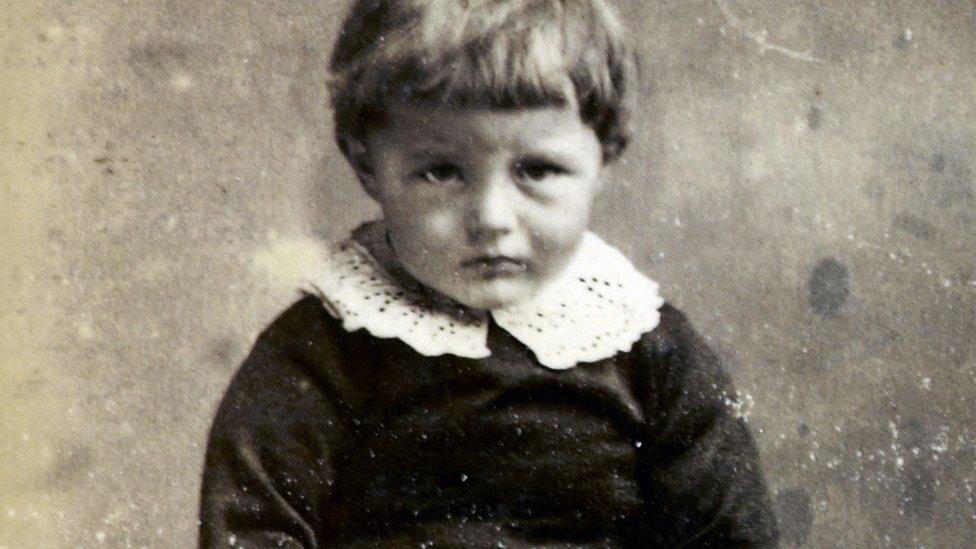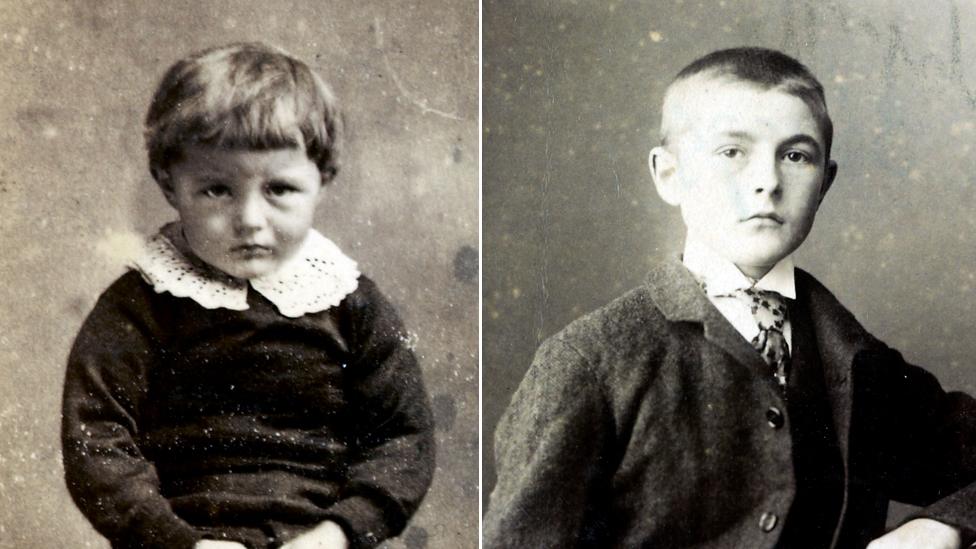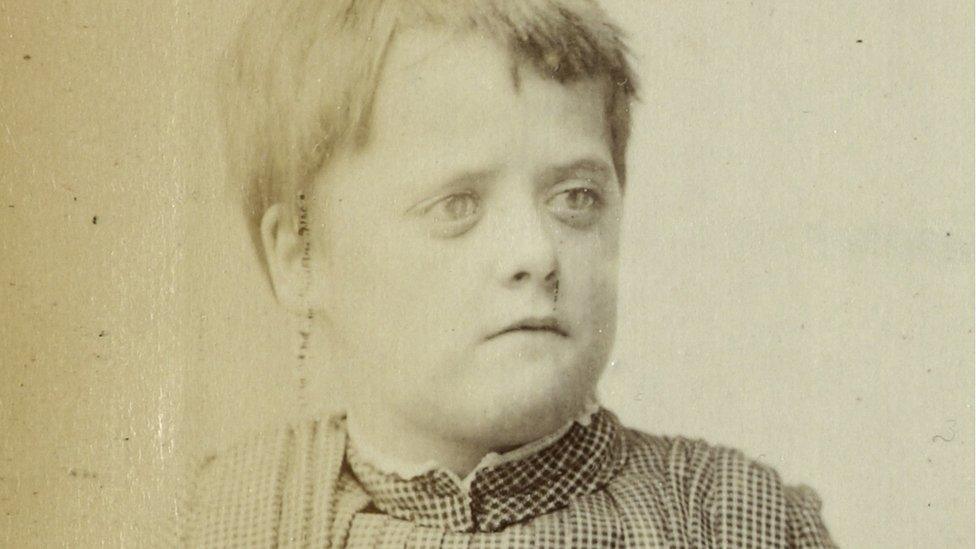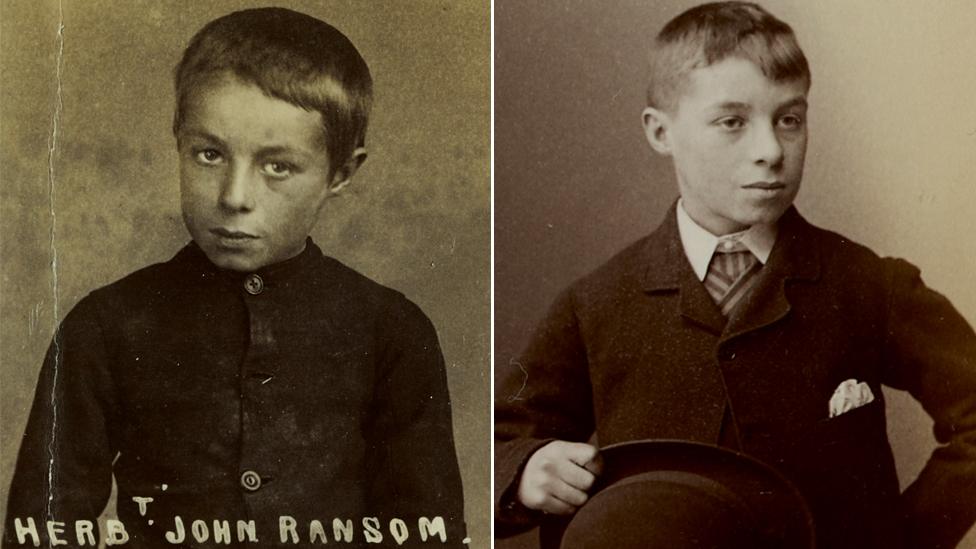Barnardo's archive photos reveal first foster children
- Published

Arnold Thilibert Borsay came from Switzerland to be admitted to Barnardo's care in 1885
Previously unseen photographs of some of England's first foster children have been released by the charity Barnardo's to mark its 150th birthday.
The images, which date back to the children's charity's early days, shed light on the lives of some of the most deprived children in Victorian society.
Dr Thomas Barnardo, who founded the charity in 1866, pioneered a scheme to move them to new countryside homes.
Among them was Elizabeth Mouncey, the UK's first known black foster child.
She was found in squalid conditions next to her dying mother, and placed with a family in Kent. Records suggest she went on to train as a cook and work in Croydon, south London.
Pollution and poverty
In his first experiment with the "boarding out" initiative in 1887, Dr Barnardo sent 320 boys, mainly from the slums of London's East End, to live with rural villagers across the south and east of England.
Many of the children had experienced abuse and neglect, with archive medical records showing that rickets, ringworm and dental problems were widespread.
The archive suggests that the fostered children showed marked improvement in health away from the pollution, poverty and overcrowding of the slums. Many went to school and went on to found jobs.
Within two years, the number of children in foster care had more than doubled - and by Dr Barnardo's death in 1905, some 4,000 children were in foster care. The charity's archives in east London contain thousands of photos of the children.
Today, about 52,000 children in England are fostered, but 9,000 more carers are needed. Releasing the archive records, Barnardo's said it hoped more people would be encouraged to become foster parents.

Lilian Murray
Born 21 September 1899

Lilian Murray was placed in care aged two
Lilian's mother led such a "wretched life" her child was made a ward of court to protect her from harm.
At two years and four months old, Lilian was placed in the custody of Barnardo's by the magistrate in Westminster after the NSPCC, which was founded in 1884, charged her mother with ill-treating and neglecting her.
In the years before Lilian was born, her mother had been imprisoned eight times for various crimes including soliciting, begging, fraud and felony.
Within a few days of being in Barnardo's care, Lilian was boarded out in the village of Bovingdon, Hertfordshire.

Elizabeth Mouncey
Born 16 November 1885

Elizabeth Mouncey, photographed at the age of six, and again at 16
Elizabeth was the first known black child to be fostered in England. She was born on Commercial Street, in the East End of London.
In 1891, six-year-old Elizabeth was found by a neighbour in squalid conditions, next to her dying mother. Within a year, her father was also dead.
After their deaths, the neighbour looked after orphaned Elizabeth in Spitalfields for a few months, while appealing to relatives to take her in.
Tragically, none felt able to give her a home. Two missionaries from different churches in London's East End appealed to Barnardo's, who took her in.

Arnold Thilibert Borsay
Born 2 August 1882

Arnold Borsay at age three, and again at 16
Arnold made regular donations all his life to Barnardo's in thanks for the 13 years of care he received, including seven years boarded out in the village of Eyke, in Suffolk.
He left Barnardo's in 1898 to work at the Hotel Belgravia on the prestigious Victoria Street, London, before migrating to British Columbia, Canada, in 1902 under the assisted passage scheme.

Elizabeth Matthews
Born 30 October 1876

Elizabeth Matthews would have been sent to the workhouse were it not for Barnardo's.
Just a week before her 13th birthday, she was taken in by a Mrs Smith at a Barnardo's "receiving house" in Copeley Hill, Birmingham.
A few days later, on 2 November 1889, her stepfather signed an agreement for Elizabeth to be looked after by Barnardo's, where she remained for the next eight years.
In November 1898 - nine years and two weeks after her stepfather signed the admission agreement - Elizabeth left Barnardo's to enter service.

Herbert John Ransom
Born 24 May 1877

Herbert John Ransom at age nine, and again at 13
When Herbert's father died of dropsy, his mother Ann struggled to provide for her seven children.
Her own poor health stopped her from taking on much work, which left her with a meagre charwoman's earnings of seven shillings per week and a parish supplementary allowance of six loaves and six shillings per week.
Sadly, this was not enough to care for all of her family, so Ann made the difficult decision to ask Barnardo's to admit all four of her sons, while the three girls stayed at their home in Manor Park, London.

James Keen
Born 18 May 1872

James Keen had a dilated heart which meant he spent time in the infirmary
On arrival from High Wycombe at Barnardo's in Stepney, 14-year-old James Keen weighed just 5st 6lbs (35kgs) and stood at a diminutive 4ft 9ins.
James had a dilated heart with symptoms including shortness of breath, fatigue, fainting spells, palpitations and chest pain and subsequently spent the first six months after admission in the infirmary.
James may have inherited his heart condition from his father, who had died of heart disease two years beforehand. His mother passed away when he was just six years old.
His grandmother, a housekeeper earning £12 per year, had taken James and his brother in after their father's death. But at 62 years old her failing health meant she was no longer able to look after them.
- Published20 June 2016